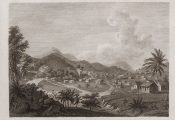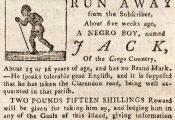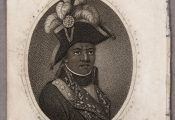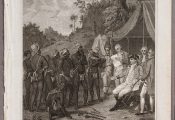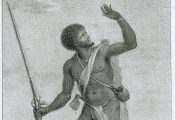There was a constant state of tension in the Caribbean between the enslaved workers and those who governed the islands, and consequently, uprisings were common. From the time that Africans were first forced to populate the islands, there was a consistent and forceful demand for freedom and democratic civil rights from the enslaved, long before antislavery campaigners took up their cause in England. As a result, each island had its own militia, one of the main functions of which was to quell slave revolts.
There were many highly planned rebellions – there is evidence that, between 1649 and 1833, about 70 of them were organised by the enslaved in British colonies. That means that there was hardly a generation of slaves in this part of the world that did not confront their enslavers with arms in pursuit of freedom.
Bussa’s Rebellion in Barbados (1816) and the Christmas Rebellion in Jamaica (1831) were led by individuals who were aware of the antislavery campaign taking place in England. Further, all of the enslaved communities in the Caribbean knew of the creation of the new republic in Haiti, which had become, for them, the main symbol of freedom.
Bussa’s Rebellion (1816)
This Barbadian rebellion was carefully planned. It was an island-wide conspiracy that involved the head workmen on the plantations – the rangers, carpenters, drivers and domestic slaves – all with the most experience and entrusted with the confidence of their masters. Bussa, the head ranger at Bayley’s plantation where the uprising began, was the main coordinator of the rebel groups. These mobilised the enslaved workers and spread rebellion propaganda that said that their owners were opposing British efforts to have them freed – if they wanted freedom, they would have to fight for it.
Not much is known about Bussa. However, the fact that he was a general manager on a plantation suggests that he was a skilled individual and probably an older man – it would have taken years to get to his position and to gain his master’s trust.
The rebellion appears to have started on Easter Sunday 1816, around 8.30pm in the south-eastern parish of St Philip and quickly spread to the southern and central parishes. The rebels eventually took over half the island, but within three days the revolt was suppressed by the local militia and the West India Regiment. Martial law was imposed and was not lifted until July 1816. A total of 111 enslaved workers and four free people of colour’ (people of mixed heritage) were executed for inciting the rebellion.
Although the rebels had lost the battle, the struggle against slavery continued in Barbados. In June 1816, a White Barbadian described in a letter the post-rebellion feeling among the slave population:
The disposition of the enslaved persons in general is very bad. They are sullen and sulky and seem to cherish feelings of deep revenge. We hold the West Indies by a very precarious tenure – that of military strength only. I would not give a year’s purchase for any island we now have.
The Christmas Rebellion (1831–2)
This uprising in Jamaica was the largest in the Caribbean in terms of the number of enslaved people involved, illustrating that slavery could not be sustained in Jamaica.
As was the case in Barbados, the enslaved population believed that emancipation was about to happen: In 1831, free ‘coloured’ people had received legal equality with Europeans, and the enslaved people believed that their turn was next. However, on 22 December, the governor Lord Belmore issued a proclamation denying the rumour that they would be free by the end of the year.
The time to seek freedom
The authorities – local politicians, plantation owners and others – held Baptist missionaries responsible for spreading these rumours, believing that they were encouraging the enslaved to fight for their freedom. The Baptists used preachers, known as ‘deacons’, to teach the principles of Christianity to the field workers – in particular, freedom and equality. Baptists did not demand immediate freedom and did not encourage the taking up of arms to achieve that aim. However, the enslaved congregations took deacons’ sermons to mean that the time had come for them to seek freedom.
Plans for revolt had been in the works for many months, long before the governor’s proclamation. As with the uprising in Barbados, those who planned and organised the rebellion were from many different plantations and comprised men and women who were literate and skilled.
Samuel Sharpe
Baptist deacon Samuel Sharpe was the main leader inasmuch as he stated the objectives of the struggle and was a field commander. As a deacon, he was able to move about freely in western Jamaica and had a reputation as an intelligent and spiritual man. At one of the final meetings before the uprising, Sharpe spoke of the ‘manifold evils and injustices of slavery’, and asserted the natural equality of all men with regard to freedom.
His plan was originally one of passive resistance, where the workers would refuse to work on Christmas Day unless they received pay and their grievances about working conditions were acknowledged. However, their demands were refused, and with the burning of the Kensington estate in western Jamaica, the protest escalated into a full-scale revolt. Over the next several days, the rebellion spread over 750 square miles, eventually involving over 60,000 of the enslaved.
Defeat and emancipation
The rebels were able to defeat the local parish militias, but they were no match for the 84th West India Regiment (part of the British forces that were garrisoned in the Caribbean), the Royal Navy and the resources of the colonial state. When the revolt was finally crushed at the end of January 1832, around 900 enslaved and 14 European planters were dead and 207 properties in five western parishes and 19 elsewhere had suffered considerable damage.
Samuel Sharpe was tried in April 1832, found guilty of rebellion and insurrection, and hanged on 23 May 1832. More than 300 other rebels were executed by hanging or firing squad.
Despite its failure, the Jamaican uprising played a significant role in the advent of abolition in the British Caribbean. A week after Sharpe’s execution, Parliament appointed a committee to consider measures for abolition. Dozens of witnesses were called to testify in London, and after months of debate, the Act for the Abolition of Slavery was passed in 1833. Samuel Sharpe’s war brought about an earlier emancipation for the enslaved, and built up their confidence that they were agents of their own liberation.
